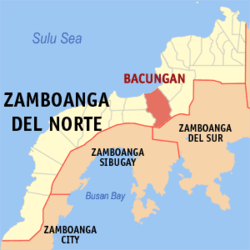Leon B. Postigo, Zamboanga del Norte
| Leon B. Postigo | |
|---|---|
| Municipality | |
| Municipality of Leon B. Postigo | |
 Map of Zamboanga del Norte with Leon B. Postigo highlighted | |
.svg.png) Leon B. Postigo Location within the Philippines | |
| Coordinates: 8°05′N 122°56′E / 8.08°N 122.93°ECoordinates: 8°05′N 122°56′E / 8.08°N 122.93°E | |
| Country |
|
| Region | Zamboanga Peninsula (Region IX) |
| Province | Zamboanga del Norte |
| District | 3rd District |
| Founded | March 25, 1982 |
| Renamed | December 30, 1989 |
| Barangays | 18 (see Barangays) |
| Government [1] | |
| • Type | Sangguniang Bayan |
| • Mayor | Hermogenes Cordova |
| • Electorate | 15,456 voters (2016) |
| Area [2] | |
| • Total | 255.50 km2 (98.65 sq mi) |
| Population (2015 census)[3] | |
| • Total | 26,221 |
| • Density | 100/km2 (270/sq mi) |
| Time zone | UTC+8 (PST) |
| ZIP code | 7112 |
| PSGC | 097226000 |
| IDD : area code | +63 (0)65 |
| Climate type | Tropical climate |
| Income class | 4th municipal income class |
| Revenue (₱) | 110,060,684.25 (2016) |
| Native languages |
Subanon language Cebuano Chavacano Tagalog |
| Website |
leonpostigo |
Leon B. Postigo, officially the Municipality of Leon B. Postigo, is a 4th class municipality in the province of Zamboanga del Norte, Philippines. According to the 2015 census, it has a population of 26,221 people.[3]
The municipality, originally named Bacungan, was formed by virtue of Batas Pambansa No. 204 on March 25, 1982.[4] It was renamed to its current name by virtue of Republic Act No. 6830 on December 30, 1989,[5] in honor of Leon Bayot Postigo, a Philippine Constabulary corporal whose 10-hectare lot in the town was donated by his heirs to the local government.[6]
Barangays
Leon B. Postigo is politically subdivided into 18 barangays.
- Bacungan (Poblacion)
- Bogabongan
- Delusom
- Mangop
- Manil
- Mawal
- Midatag
- Morob
- Nasibac
- Palandok (Rizon)
- Santa Maria
- Sipacong
- Talinga
- Tinaplan
- Tiniguiban
- Tinuyop
- Tiogan
- Titik
Demographics
| Population census of Leon B. Postigo | ||
|---|---|---|
| Year | Pop. | ±% p.a. |
| 1990 | 14,618 | — |
| 1995 | 20,728 | +6.76% |
| 2000 | 19,550 | −1.25% |
| 2007 | 21,195 | +1.12% |
| 2010 | 24,643 | +5.64% |
| 2015 | 26,221 | +1.19% |
| Source: Philippine Statistics Authority[3][7][8][9] | ||
See also
References
- ↑ "Municipality". Quezon City, Philippines: Department of the Interior and Local Government. Retrieved 31 May 2013.
- ↑ "Province: Zamboanga del Norte". PSGC Interactive. Quezon City, Philippines: Philippine Statistics Authority. Retrieved 12 November 2016.
- 1 2 3 Census of Population (2015). "Region IX (Zamboanga Peninsula)". Total Population by Province, City, Municipality and Barangay. PSA. Retrieved 20 June 2016.
- ↑ http://www.chanrobles.com/bataspambansa/bataspambansablg204.html
- ↑ http://www.chanrobles.com/republicacts/republicactno6830.html
- ↑ "Archived copy". Archived from the original on 2013-07-26. Retrieved 2012-04-15.
- ↑ Census of Population and Housing (2010). "Region IX (Zamboanga Peninsula)". Total Population by Province, City, Municipality and Barangay. NSO. Retrieved 29 June 2016.
- ↑ Censuses of Population (1903–2007). "Region IX (Zamboanga Peninsula)". Table 1. Population Enumerated in Various Censuses by Province/Highly Urbanized City: 1903 to 2007. NSO.
- ↑ "Province of Zamboanga del Norte". Municipality Population Data. Local Water Utilities Administration Research Division. Retrieved 17 December 2016.
External links
This article is issued from
Wikipedia.
The text is licensed under Creative Commons - Attribution - Sharealike.
Additional terms may apply for the media files.